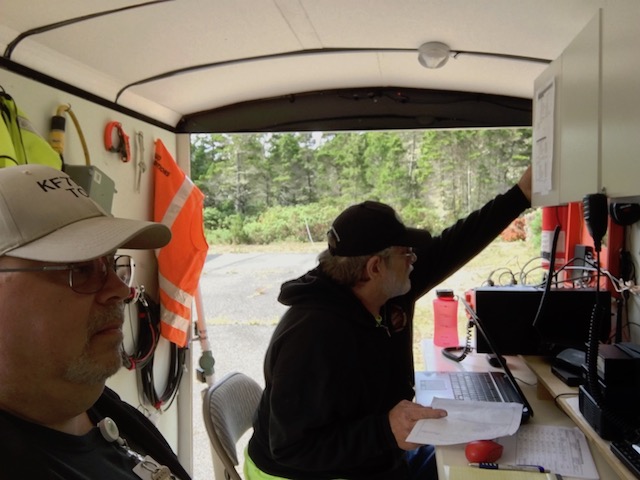KF7RSF Doing More With Less
Doing More with Less
June 30, 2017
http://theworldlink.com/news/local/disaster-response-exercise-succeeds-s...
The threat to coastal British Columbia, Washington, Oregon, and Northern California from a massive earthquake and following tsunami has been recognized for years, and has been the focus of continued training by numerous EMCOMM groups.
An exercise to ascertain the usefulness of a remote Oregon coastal airport to support heavy airlift of supplies in, and casualties out, was held June 23-27 2017, at Cape Blanco State Airport in Curry County Oregon. This airport was built during WWII to support heavy bombers and submarine patrols, and is one of the very few airports able to handle heavy transports that is expected to survive and be usable after the Cascadia Subduction Zone earthquake and expected tsunami.
This exercise involved over 40 Agencies, from local law enforcement and fire personnel, all the way up to Federal agencies such as FEMA and DHS. Air assets included Coast Guard, Air National Guard, and private Air Ambulance helicopters, and Civil Air Patrol and other fixed wing aircraft. The intent was to test the locally available resources' ability to come together and initiate a relief operation. The scenario began 36 hours after the Richter 9.2 earthquake, and continued for the subsequent 3 days. All commercial power, Cell phone service, and local repeater service was considered down and unavailable.
The Coos and Curry County Amateur radio community was tasked with handling the communications for the exercise, to include the hub at Cape Blanco Airport as well as communications to and from 4 additional Casualty Collection Points (CCPs) scattered in the two adjoining counties. The CCPs were to collect the injured victims, perform initial triage, and then either transfer to community hospitals, or on to Cape Blanco if the local facilities were unable to accept more. At Cape Blanco medical personnel would perform secondary triage, and if needed transfer the casualties out to inland unaffected areas.
The terrain in this area of Coastal southern Oregon is rugged and sparsely populated. The hills and distance made it impossible to use simplex VHF communications between the airport hub and the outlying CCPs. The current solar cycle nadir and distances involved made NVIS HF communications difficult to impossible by voice. The most northern CCP could easily talk to the most southern, but neither could successfully talk to the airport. Compounding this is the fact that this exercise was scheduled the same weekend as the US ARRL Field Day event, which closely approximated the expected surge in HF band activity expected to follow a major natural disaster, to the point of saturation. A recipe for failure!
Winlink 2000 to the rescue.
We quickly confirmed on the first morning that voice VHF or HF was not going to succeed, and switched to use of Winlink Express for nearly 100% of message traffic. The hub station at the airport, based in the Coos County portable communications trailer, was set up as a full Winlink Gateway with HF Winmor and Pactor, VHF Packet for local users, and a WiFi Local Area Network (LAN) for Telnet connections. All the CCPs were able to easily reach Winlink RMS Gateways out of the affected area and insert and retrieve message traffic. The stations did frequent (15 minute) connections to reduce message lag time. The airport hub station was configured as a HF Forwarding Gateway with no internet, and had multiple keyboard clients transcribing paper message traffic and sending by Telnet to the Gateway Server. The RMS Gateway server would accept messages, suspend scanning HF, and connect to a remote RMS Gateway - borrowing that Gateway’s internet connection to send traffic via a CMS, as well as check for any inbound traffic for a local user at the LAN. Reply message traffic was printed and delivered to the Incident Command Post (ICP) for record keeping. As the entire exercise was designed to utilize the FEMA mandated ICS command structure, all message traffic was on well recognized ICS-213 HTML Template Forms incorporated in Winlink Express.
The LAN could have been extended to cover the ICP, and non-licensed personnel trained to use Winlink Express by telnet with Tactical Callsigns, to extend the volume of communications as desired. This short exercise did not allow this to be more than demonstrated as a viable technique.
The Communications group was able to handle all traffic submitted with little trouble, and as well handled traffic directed at County and State Offices of Emergency Management such as Resource Requests for supplies. Communications testing was only one part of the exercise, and occupied only a few hours each day. In those hours we sent and received over 100 messages error free.
My heartfelt thanks to my personal Mentor on all things Winlink, XE2/N6KZB, Member WDT, for the extensive training received.
Attached photo KF7RSF foreground, KE7EIB background, operating from the Communications trailer.
Thomas W Noel
KF7RSF

- KF7RSF's blog
- Log in to post comments
